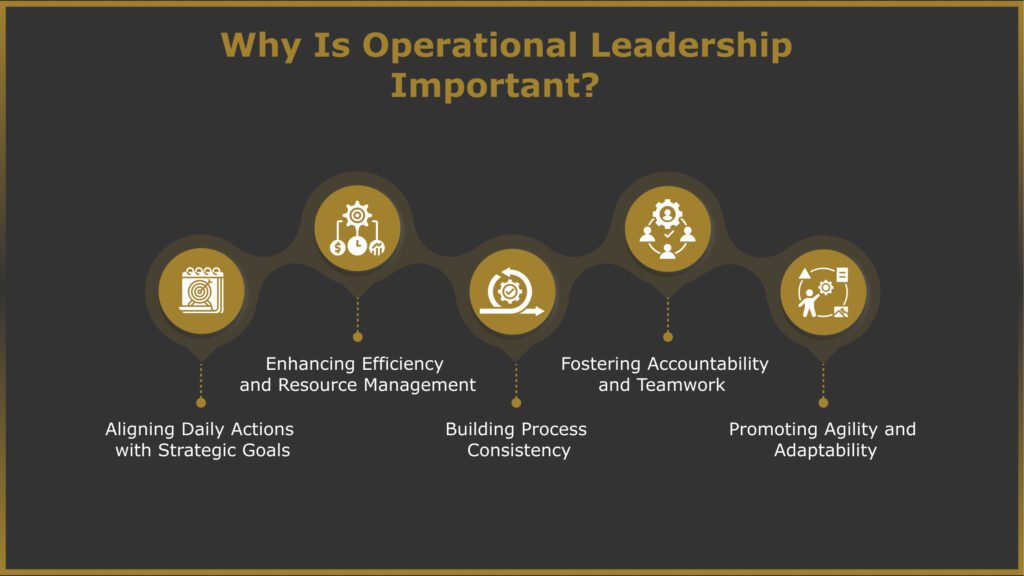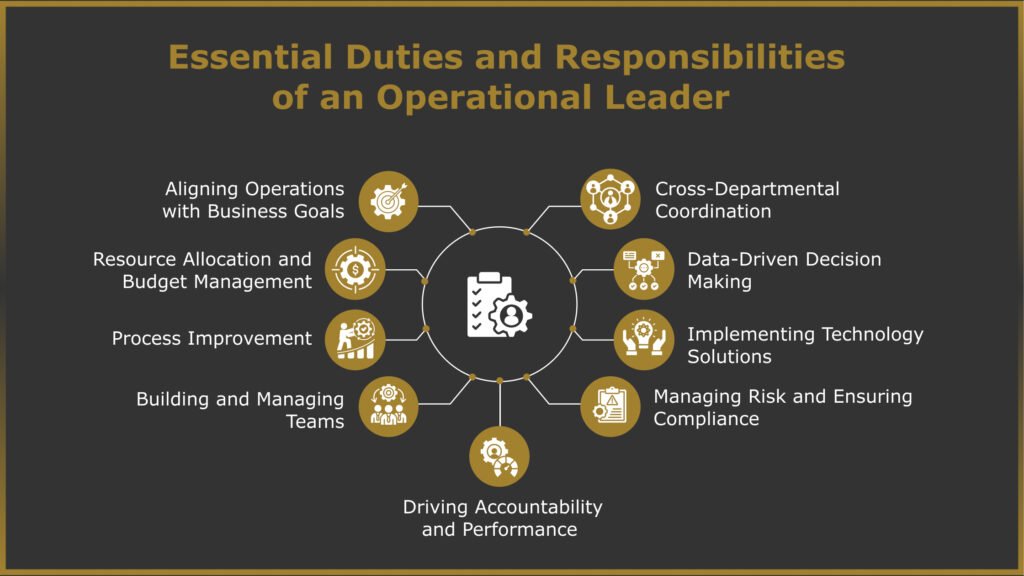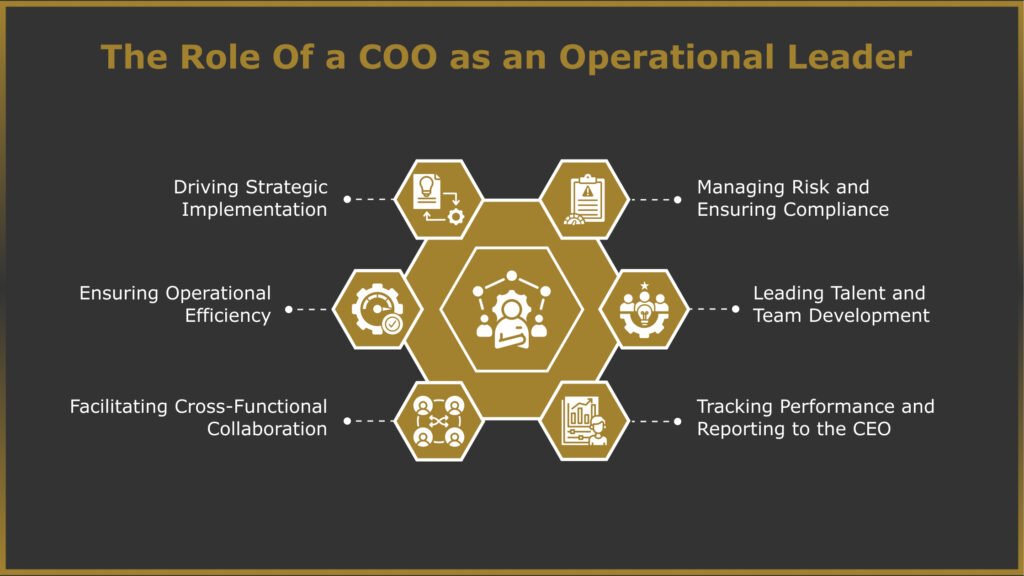Operational leadership is a fundamental pillar for companies aiming to grow while maintaining efficiency and strong team alignment. It is defined by a leader’s ability to connect vision with actionable steps. Operational leaders ensure that the company’s strategies translate into effective day-to-day practices across departments.
According to a study, 80% of employees enjoy working with good leaders and management to avoid stress. Further, companies with strong operational leadership structures achieve their annual targets more frequently than those without structured operations.
Why Is Operational Leadership Important?

Operational leadership connects business goals with everyday actions, making strategy achievable. It also strengthens efficiency, consistency, and adaptability across the company. Below are some important reasons why operation leadership is important.
1. Aligning Daily Actions with Strategic Goals
Operational leadership ensures that a company’s day-to-day actions align closely with its strategic objectives. This alignment bridges the gap between high-level goals and actual execution, ensuring that each action supports the bigger picture.
2. Enhancing Efficiency and Resource Management
Strong operational leaders optimize workflows and resource allocation, improving efficiency. Effective resource management enhances productivity and profitability, directly contributing to the company’s financial health.
3. Building Process Consistency
Operational leadership is essential for standardizing processes. This consistency is critical to maintaining quality, meeting customer expectations, and adhering to industry standards. Consistent processes lead to reliability, a crucial factor for long-term success.
4. Fostering Accountability and Teamwork
Effective operational leaders foster a culture of accountability and collaboration. They set clear objectives for employees, helping each team member understand their role in achieving the company’s mission. This clarity reduces turnover and boosts morale, as employees feel valued and motivated.
5. Promoting Agility and Adaptability
Operational leaders keep the company agile by identifying and resolving inefficiencies and quickly responding to changes in the market or industry. This adaptability drives process improvements, helping the company evolve and remain competitive.
Essential Duties and Responsibilities of an Operational Leader

Operational leaders play a central role in managing and optimizing the daily functions of a company, ensuring that strategies are carried out efficiently and goals are met. Here are some of the essential duties they perform:
1. Aligning Operations with Business Goals
Operational leaders are responsible for translating the company’s strategic objectives into actionable plans that align with everyday operations. This includes setting departmental goals and metrics that drive productivity and contribute to the mission.
2. Resource Allocation and Budget Management
Effective operational leadership involves managing resources, including budgets, personnel, and equipment, to ensure they’re optimally used. Leaders track expenditures and allocate resources where they will drive the most value, helping maintain cost efficiency across departments.
3. Process Improvement
Operational leaders continuously assess processes to identify inefficiencies or areas for improvement. They may implement new procedures, adopt best practices, and leverage technology to streamline workflows, ultimately increasing productivity and reducing costs.
4. Building and Managing Teams
An operational leader is tasked with recruiting, training, and retaining talent and ensuring the team has the skills and motivation to meet its goals. They focus on creating a supportive environment where employees can perform their best and grow within the company.
5. Driving Accountability and Performance
Leaders in this role set clear expectations, monitor performance, and hold team members accountable. This includes establishing key performance indicators (KPIs) and conducting regular assessments to gauge individual and team progress, helping maintain a high standard of work.
6. Managing Risk and Ensuring Compliance
Operational leaders identify potential risks within processes, such as regulatory or compliance issues, and take proactive steps to address them. They ensure that all activities meet industry regulations and standards, which protects the company from legal and reputational risks.
7. Cross-Departmental Coordination
Operational leaders work closely with other departments to ensure cohesion and collaboration and address interdepartmental challenges. This alignment fosters better communication, more efficient workflows, and the cooperation of all teams toward shared goals.
8. Data-Driven Decision Making
Effective operational leaders rely on data to inform their decisions. They use analytics and reporting tools to gain insights into operational efficiency, monitor performance trends, and make informed adjustments that enhance outcomes and optimize resources.
9. Implementing Technology Solutions
Adopting the right technology is crucial for efficiency, and operational leaders often spearhead these initiatives. They identify tools that can automate repetitive tasks, streamline workflows, and enhance communication, ensuring the organization stays competitive and efficient.
Operational leaders manage the intricate details of daily business and maintain a strategic outlook that keeps the organization adaptable and resilient in a changing market. Their role is foundational for aligning processes with the company’s mission, driving efficiency, and ensuring sustainable growth.
Traits of an Effective Operational Leader
Operational leaders hold a unique blend of skills and qualities that equip them to manage complex processes while motivating teams to perform at their best. Here are some of the key traits that define a highly effective operational leader:
|
Trait |
Description |
|
Strategic Vision with Tactical Execution |
Balances long-term vision with hands-on involvement, ensuring high-level goals are achieved through practical steps. |
|
Analytical and Data-Driven |
Uses data to make informed decisions, track performance, and drive process improvements effectively. |
|
Adaptability and Resilience |
Stays flexible and proactive in addressing changes, demonstrating resilience, and guiding teams through business transitions. |
|
Communication Skills |
Communicates clearly across all levels, ensuring alignment and understanding between executive leadership, team members, and other stakeholders. |
|
Empathy and Team Empowerment |
Promotes a supportive environment, empowering team members to take ownership of their roles, which promotes accountability and trust within the team. |
Examples of Operational Leadership in Action
Here are some examples showing how an effective leader addresses real-world challenges to maintain efficiency and support strategic goals:
1. Addressing a Sudden Resource Shortage
When faced with an unexpected shortage—like a staffing gap during a high-demand period—an operational leader quickly assesses available resources and reallocates them as needed. They might assign high-priority tasks to existing staff and negotiate short-term help or overtime to maintain production or service levels.
This approach limits disruptions while meeting immediate demands, ensuring that essential operations continue smoothly until the resource gap is resolved.
2. Streamlining Communication Between Departments
To tackle communication barriers between departments (e.g., between sales and fulfillment teams), an operational leader might introduce regular cross-departmental briefings or shared digital platforms to keep everyone aligned on timelines, goals, and obstacles.
Creating structured, consistent communication channels, they help avoid misunderstandings and inefficiencies, fostering a cooperative environment that supports daily functions and strategic objectives.
3. Implementing a New System or Process to Address Inefficiencies
Recognizing recurring delays in order processing, an operational leader might initiate implementing an updated inventory management system. They would plan the rollout to include training for team members and establish benchmarks to measure improvements.
By introducing this new process, they streamline workflows, reduce errors, and increase efficiency, ultimately aligning operations with broader business goals like improving customer satisfaction and meeting delivery deadlines.
In each scenario, the operational leader’s proactive approach directly contributes to smooth operations, improved communication, and enhanced productivity, all of which support the company’s long-term objectives.
The Role Of a COO as an Operational Leader

The Chief Operating Officer (COO) plays a central role as an operational leader, bridging strategy and execution within a company. Here are some key roles and responsibilities of a COO in this capacity:
1. Driving Strategic Implementation
The COO translates high-level strategies into practical, executable steps, aligning daily operations with the company’s long-term vision. This role involves creating and overseeing action plans that support business goals, monitoring the progress of these initiatives, and ensuring all teams are moving in sync.
The COO helps ensure that strategic priorities are met on time and within budget, bridging the gap between the CEO’s broader vision and day-to-day execution.
2. Ensuring Operational Efficiency
A crucial role of the COO as an operational leader is to ensure efficiency in all processes. This involves continuously evaluating operations across departments to identify and implement improvements.
Whether it’s refining workflows, optimizing resource use, or reducing unnecessary costs, the COO focuses on minimizing waste and increasing productivity. By fostering efficiency, the COO helps the organization deliver quality products or services more effectively, directly impacting the bottom line.
3. Facilitating Cross-Functional Collaboration
A COO facilitates communication and collaboration among departments, ensuring they work together to meet shared objectives. This coordination requires a comprehensive understanding of each department’s function and how they interconnect within the organization.
The COO resolves interdepartmental conflicts, addresses communication gaps, and establishes unified processes that help departments operate smoothly as one cohesive unit. Effective collaboration under the COO’s guidance can enhance productivity, innovation, and overall company morale.
4. Managing Risk and Ensuring Compliance
A COO manages operational risks by identifying and addressing potential company processes and system vulnerabilities. This involves overseeing risk management policies, internal controls, and compliance measures to protect the organization’s assets, data, and reputation. The COO ensures that the company meets regulatory requirements and proactively addresses risks, helping to prevent disruptions, financial losses, and legal liabilities.
5. Leading Talent and Team Development
A COO plays a crucial role in talent development, focusing on recruiting, retaining, and nurturing high-performing teams. This responsibility includes building a supportive workplace culture, providing professional development opportunities, and addressing employee needs and concerns. The COO helps ensure that team members are well-equipped, motivated, and aligned with the company’s vision, leading to improved employee engagement and productivity.
6. Tracking Performance and Reporting to the CEO
COOs monitor the company’s performance through key performance indicators (KPIs) and metrics that align with the organization’s objectives. By analyzing data and performance trends, they can make informed decisions, identify improvement areas, and measure the impact of operational changes.
Regular reporting to the CEO provides insights into ongoing projects, successes, and challenges, enabling the leadership team to make necessary strategic adjustments. This consistent evaluation keeps the company on track toward achieving its long-term goals.
Get the Best Operating Leader for Your Business with Outcomes COO!

Ready to boost your business operations, simplify workflows, and drive sustainable growth? Outcomes COO provides strategic, hands-on operational support tailored for growing businesses. With a focus on small to mid-sized companies, Outcomes COO offers Fractional COO services, ensuring expert operational guidance without the commitment of a full-time role. Here’s how Outcomes COO can support your business:
- Fractional COO/Integrator Services: Expert operational leadership for businesses between $4M and $40M in revenue, offering high-level operational strategy.
- Leadership Delegation: Allow business owners to focus on vision while Outcomes COO handles day-to-day management and operational oversight.
- Organizational Alignment: Ensure that the right talent is in place, focusing on aligning teams and departments toward a common goal.
- Data-Driven Accountability: Develop departmental scorecards to drive performance and accountability across all levels.
- Efficient Process Integration: Streamline company processes, improve efficiency, and maintain alignment with strategic objectives.
Outcomes COO partners with you to ensure that every part of your business is aligned, efficient, and poised for growth.

